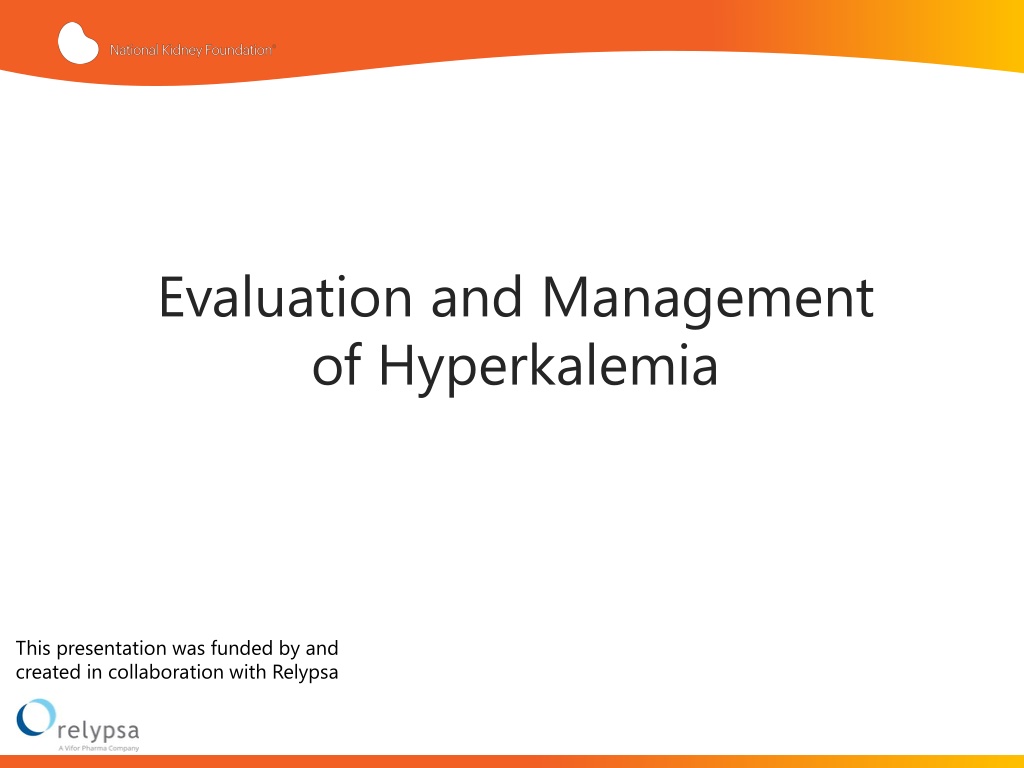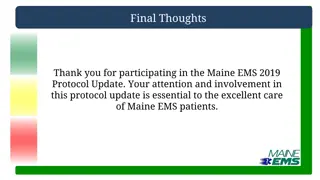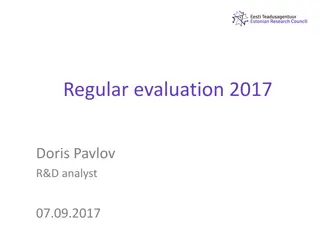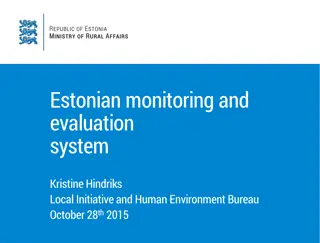Understanding Hyperkalemia: Causes, Evaluation, and Management
Hyperkalemia is a condition characterized by elevated serum potassium levels, posing serious risks such as cardiac arrhythmias and sudden death. Pathogenesis involves factors like abnormal potassium release, impaired distribution, and excretory process impairment. Causes range from pseudohyperkalemia to conditions affecting kidney function. Effective evaluation and management strategies are crucial, with emphasis on understanding the pathophysiology, risk factors, testing methods, and treatment approaches in patients with kidney disease.
Download Presentation

Please find below an Image/Link to download the presentation.
The content on the website is provided AS IS for your information and personal use only. It may not be sold, licensed, or shared on other websites without obtaining consent from the author. Download presentation by click this link. If you encounter any issues during the download, it is possible that the publisher has removed the file from their server.
E N D
Presentation Transcript
Evaluation and Management of Hyperkalemia This presentation was funded by and created in collaboration with Relypsa
Agenda Pathogenesis of Hyperkalemia Evaluation of Hyperkalemia Hyperkalemia Management
Learning Objectives Describe the pathophysiology of hyperkalemia Understand hyperkalemia-associated risk factors, including kidney disease Discuss evaluation and methods of testing for hyperkalemia Discuss treatment strategies in kidney disease patients with hyperkalemia
Hyperkalemia A potentially serious medical condition in which elevated serum potassium levels can increase the risk of severe cardiac electrophysiology abnormalities (e.g., cardiac arrhythmias) and sudden death
Hyperkalemia Can result from one or a combination of these factors: Abnormal net release of potassium from cells Impaired distribution between intracellular and extracellular spaces Impairment of potassium excretory process Increased potassium load Dunn J, et al. Am J Manag Care. 2015;21:s307-s315. Allon M. NKF Primer on Kidney Diseases. 2014.
Causes of Hyperkalemia Pseudohyperkalemia Hemolysis Thrombocytosis Severe Leukocytosis Fist clenching (venipuncture) Abnormal Potassium Distribution Insulin Deficiency Beta-blockers Metabolic or respiratory acidosis Familial hyperkalemic periodic paralysis Abnormal Potassium Release from Cells Rhabdomylosis Tumor Lysis syndrome Decreased Renal Excretion Acute or Chronic kidney disease Diseases that impact kidney function (e.g., lupus) Aldosterone deficiency Adrenal insufficiency Heart failure Drugs that inhibit potassium excretion Modified from Allon M. NKF Primer on Kidney Diseases. 2014.
Pathogenesis of Hyperkalemia: RAAS and Potassium Excretion RAAS, renin-angiotensin-aldosterone system Palmer B. Am J Kidney Dis. 2010;56:387-393.
Drugs Known to Induce Hyperkalemia Method of Induction Examples Drug-inducing transmembrane potassium movement Non-selective beta blockers Digoxin intoxication Intravenous cationic amino acids Mannitol Suxamethonium Drugs that affect aldosterone secretion ACE inhibitors ARBs Direct renin inhibitors NSAIDs and COX-2 inhibitors Calcineurin inhibitors Drugs that cause tubular resistance to the action of aldosterone Aldosterone antagonists Potassium-sparing diuretics Trimethoprim, pentamidine Potassium-containing agents Salt substitutes and alternatives Penicillin G, stored blood products Ben Salem C, et al. Drug Saf. 2014;37:677-692.
Hyperkalemia and CKD Patients with CKD are at higher risk for hyperkalemia, due to their decreased ability to excrete potassium, and the presence of other comorbid/predisposing conditions (e.g., diabetes, CVD) Hyperkalemia has been reported as high as 40-50%, in CKD patients (compared to 2-3% in the general population) Kovesdy C. Nat Rev Nephrol. 2014;10:653-662.
All-Cause Mortality Associated With Serum Potassium Levels in Patients with CKD Non-Dialysis CKD1 Dialysis2 Multivariable adjusted log hazards (solid line) and 95% confidence intervals (dashed lines) of all-cause predialysis mortality associated with serum potassium levels in the entire study population (n=1,227). Association of serum potassium, used as a time-varying covariate, with mortality in patients undergoing peritoneal dialysis (n=10,454). Dashed lines represent 95% confidence intervals. 1) Hayes J, et al. Nephron Clin Pract. 2012;120:c8-c16. 2) Torl n K, et al. Clin J Am Soc Nephrol. 2012;7:1272-1284.
Risk Factors for Hyperkalemia in CKD Potassium intake Metabolic acidosis RAAS inhibition Diabetes Heart failure Coronary artery and peripheral vascular disease RAASi, renin-angiotensin-aldosterone system inhibitors. Kovesdy C. Nat Rev Nephrol. 2014;10:653-662.
Mechanisms of Hyperkalemia in CKD Kovesdy CP. Nat Rev Nephrol. 2014;10:653-662.
Hyperkalemia: Symptoms Often asymptomatic, but patients may report non-specific symptoms, including palpitations, nausea, muscle pain, weakness, dyspnea, or paresthesia Hyperkalemia can lead to disturbances of cardiac rhythm, which can be fatal Viera A, Wouk N. Am Fam Physician. 2015;92:487-495. Epstein M, et al. Am J Manag Care. 2015;21(11 Suppl):S212-S220.
Hyperkalemia: Serum Potassium Levels Hyperkalemia is defined as a serum potassium level above the normal/reference range (3.0 - 5.0 mEq/L*) Various cutoffs, such as >5.0, >5.5, or >6.0 mEq/L have been used to indicate different levels of severity Severe hyperkalemia is most often defined as serum levels >6 mEq/L *Reference range may vary by lab. 1) Kovesdy C. Nat Rev Nephrol. 2014;10:653-662.
Acute Versus Chronic Hyperkalemia Acute Hyperkalemia Chronic Hyperkalemia Requires immediate attention (e.g., cardiac monitoring, acute medical interventions, possibly dialysis) Requires ongoing management to correct underlying disturbances in potassium balance (i.e., nonpharmacological and pharmacological interventions) Kovesdy C. Nat Rev Nephrol. 2014;10:653-662. Viera A, Wouk N. Am Fam Physician. 2015;92:487-495.
Hyperkalemia Diagnosis Clinical history Physical examination Review of medications Assessment of cardiac function, kidneys, and urinary tract Assessment of hydration status Electrocardiogram Comprehensive laboratory workup Viera A, Wouk N. Am Fam Physician. 2015;92:487-495.
Diagnostic Algorithm of Hyperkalemia *-Symptoms of hyperkalemia, changes on electrocardiography, rapid-onset hyperkalemia, or underlying heart disease, cirrhosis, or kidney disease. Viera A, Wouk N. Am Fam Physician. 2015;92:487-495.
Electrocardiograph Changes Seen in Patients With Hyperkalemia* EKG features of hyperkalemia:1 5.5-6.5 mEq/L: Tall peaked T waves 6.5-7.5 mEq/L: Loss of P waves 7.0-8.0 mEq/L: Widening of QRS complexes 8.0-10.0 mEq/L: Sine wave, ventricular arrhythmias, asystole *EKG changes not always present 1. Slovis C, Jenkins R. BMJ. 2002;324:1320.
Management Goals: Acute Versus Chronic Hyperkalemia Acute Hyperkalemia Chronic Hyperkalemia Prevent potentially life-threatening cardiac conduction and neuromuscular disturbances Shift potassium into cells Eliminate excess potassium Resolve underlying disturbance Prevent the development or recurrence of hyperkalemia Correct underlying defects in potassium homeostasis Increase potassium excretion (e.g., diuretics, potassium binders) Dunn J, et al. Am J Manag Care. 2015;21:s307-s315. Viera A, Wouk N. Am Fam Physician. 2015;92:487-495. Kovesdy C. Nat Rev Nephrol. 2014;10:653-662.
Management Approaches to Hyperkalemia Acute Management Chronic Management Remove or manage any ongoing contributors to hyperkalemia Diet Medications Co-morbid conditions Stabilize: Evaluate patient for life- threatening toxicities Initiate EKG monitoring Ca-Gluconate Shift: Augment the shift of potassium from extra- to intracellular space Dextrose and/or insulin infusion Beta-adrenergic agonists Sodium bicarbonate Increase excretion of potassium Loop diuretics (furosemide) Mineralocorticoid accentuation Potassium binders Remove: Renal replacement therapy Hemodialysis CRRT Potassium binders Kovesdy C. Nat Rev Nephrol. 2014;10:653-662. Viera A, Wouk N. Am Fam Physician. 2015;92:487-495. Dunn J, et al. Am J Manag Care. 2015;21:s307-s315. CRRT, Continuous Renal Replacement Therapy
Dietary Modifications in CKD that can Potentially Worsen Hyperkalemia Increased dietary potassium intake from salt substitute (potassium chloride) Herbal supplements (noni, alfalfa, dandelion, etc.) Potassium-rich heart-healthy diets Allon M. NKF Primer on Kidney Diseases. 2014. Kovesdy C. Nat Rev Nephrol. 2014;10:653-662.
Potassium Content of Select Foods Considered High in Potassium Food Potassium (mg) Potassium (mEq) Pinto beans (1 cup) 1370 35 Raisins (1 cup) 1106 28 Honeydew (1/2 melon) 939 24 Nuts (1 cup) 688 18 Black-eyed peas (1 cup) 625 16 Collard greens (1 cup) 498 13 Banana (1 medium) 440 11 Tomato (1 medium) 366 9 Orange (1 large) 333 9 Milk (1 cup) 351 9 Allon M. NKF Primer on Kidney Diseases. 2014.
Restriction of Dietary Potassium Potassium in DASH diet: Approximately 4.5 g/d DASH Diet should not be routinely recommended to patients with GFR <60 mL/min Guidelines recommend potassium intake of 2-4 g/d for patients with CKD stages 3-4 (GFR 15-59 mL/min) Hyperkalemia risk is especially high in patients with GFR <30 mL/min receiving ACEi or ARB therapy, or other conditions that raise serum potassium More stringent potassium intake may be required Low potassium diet" target intake: 2-3 g/d Kidney Disease Outcomes Quality Initiative (KDOQI). Am J Kidney Dis. 2004;43(5 Suppl 1):S1-S290. Dash, Dietary Approaches to Stop Hypertension
Dialysis and Hyperkalemia Plasma Potassium Concentration During and After Dialysis3 Hemodialysis: Acute/Chronic Peritoneal dialysis: Chronic Effects of dialysis on serum sodium, bicarbonate, calcium and/or magnesium levels can affect results1 For chronic hemodialysis, missed treatments and 2-day interdialytic interval may have a negative impact on outcomes (i.e., mortality, hospital admission for CV events) 2 1) Kovesdy C. Nat Rev Nephrol. 2014;10:653-662. 2) Foley R, et al. N Engl J Med. 2011;365:1099-1107. 3) Sterns R, et al. Kidney Int. 2016;89,546-554.
Dialysate Potassium and Clinical Outcomes: DOPPS Associations Between Dialysate Potassium and Clinical Outcomes by Predialysis Serum Potassium Concentration Predialysis Serum Potassium All Patients <4.0 mEq/L 4.0-5.0 mEq/L 5.1-6.0 mEq/L >6.0 mEq/L All-cause mortality: Dialysate potassium 3.0 vs 2.0 mEq/L (reference) 0.96 (0.91- 1.01) 1.03 (0.91- 1.17) 0.96 (0.90- 1.03) 0.94 (0.85- 1.03) 0.97 (0.78- 1.20) Arrhythmia composite: Dialysate potassium 3.0 vs 2.0 mEq/L (reference) 0.98 (0.88- 1.08) 1.13 (0.86- 1.47) 0.91 (0.80- 1.04) 1.06 (0.89- 1.27) 1.15 (0.81- 1.62) DOPPS, Dialysis Outcomes and Practice Patterns Study Karaboyas A, et al. Am J Kidney Dis. 2017;69:266-277.
Possible Strategies for SCD Prevention in HD SCD, Sudden cardiac death; HD, Hemodialysis Makar M, Pun P. Am J Kidney Dis. 2017 Feb 17. [Epub ahead of print]
Potassium Binders Route of Administration Onset/ Duration Treatment Mechanism Comments Cannot be used in medical emergencies Cases of intestinal necrosis, which may be fatal, and other serious GI adverse events have been reported Caution in patients with heart failure due to sodium load May cause hypokalemia and electrolyte disturbances Oral or rectal (either acute or chronic), with or without sorbitol Cation exchange resin Sodium polystyrene sulfonate 25-50 g 1-2 h 4-6 h Excretion Should not be used as an emergency treatment for life-threatening hyperkalemia because of its delayed onset of action Contraindicated in patients with a history of a hypersensitivity reaction to VELTASSA or any of its components Risks include Worsening of Gastrointestinal Motility and Hypomagnesemia The most common Adverse Reactions in clinical trials were constipation, hypomagnesemia, diarrhea, nausea, abdominal discomfort and flatulence Cation exchange polymer Patiromer 8.4, 16.8, or 25.2 g Oral (either acute or chronic) 7 h ~48 h Excretion 1. SPS Package Insert 2. Patiromer Package Insert
RAAS Inhibition and CKD ACEis and ARBs are primarily used for hypertension, and are well-established treatments for many chronic diseases, including CKD, heart failure, and diabetic nephropathy However RAAS inhibition can impair renal potassium secretion, thus increasing the risk of hyperkalemia This can raise a dilemma in treating patients with CKD or other conditions Kovesdy C. Nat Rev Nephrol. 2014;10:653-662.
Adverse Outcomes or Mortality by Prior RAAS Inhibitor Dose Epstein M, et al. Am J Manag Care. 2015;21(11 Suppl):S212-S220.
Considerations for Managing Patients at Risk for Hyperkalemia Caused by RAAS Inhibition Monitor kidney function (eGFR, ACR) Monitor serum potassium levels Discontinue drugs that increase hyperkalemia risk, if possible Prescribe low-potassium diet Prescribe diuretics (loop diuretics when eGFR <30 mL/min) Correct metabolic acidosis in patients with CKD If required, initiate therapy with low-dose ACEi or ARB and monitor Newer potassium binders may offer a potential option to continue RAAS inhibition in patients who need these therapies Modified form Palmer B. N Engl J Med. 2004;351:585-592. Makar M, Pun P. Am J Kidney Dis. 2017. [Epub ahead of print] Sterns R, et al. Kidney Int. 2016;89:546-554. Dunn J, et al. Am J Manag Care. 2015;21(15 Suppl):s307-s315. GFR, glomerular filtration rate; ACR, albumin-to-creatinine ratio; RAAS, Renin-Angiotensin-Aldosterone System
Summary Hyperkalemia can lead to adverse cardiac outcomes and mortality Medications and co-morbid conditions (e.g., CKD) can contribute to high serum potassium Approaches include low potassium diet and avoidance/dose-adjustments of certain medications Other measures include bicarbonate, diuretics, potassium binders

























